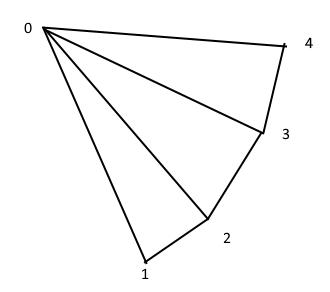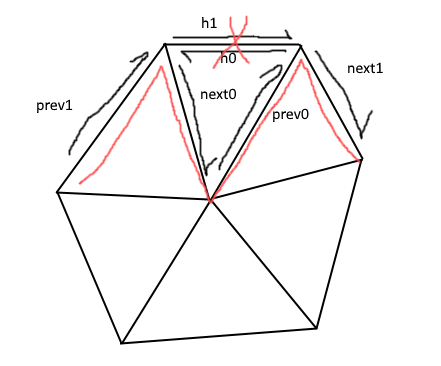openmesh - src - trimesh delete and add elements
openmesh - src - trimesh delete and add elements
openmesh 版本 8.1
About
本文主要介绍openmesh的如下接口
- add_vertex
- add_face
- delete_vertex
- delete_edge
- delete_face
- delete_isolated_vertices
add_vertex
入口代码位于:\src\OpenMesh\Core\Mesh\PolyMeshT.hh。涉及到的源代码如下:
template <class Kernel>
class PolyMeshT : public Kernel
{
/// Alias for new_vertex(const Point&).
inline SmartVertexHandle add_vertex(const Point& _p)
{ return new_vertex(_p); }
/**
* \brief Adds a new vertex initialized to a custom position.
*
* \sa new_vertex(), new_vertex_dirty()
*/
inline SmartVertexHandle new_vertex(const Point& _p)
{
VertexHandle vh(Kernel::new_vertex());
this->set_point(vh, _p);
return make_smart(vh, this);
}
//..............
}
// kernel::new_vertex
class OPENMESHDLLEXPORT ArrayKernel : public BaseKernel, public ArrayItems
{
inline VertexHandle new_vertex()
{
vertices_.push_back(Vertex());
vprops_resize(n_vertices());//TODO:should it be push_back()?
return handle(vertices_.back());
}
// --- handle -> item ---
VertexHandle handle(const Vertex& _v) const
{
return VertexHandle( int( &_v - &vertices_.front()));
}
}
// AttribKernelT
// 顶点的位置,作为顶点的属性进行管理
template <class MeshItems, class Connectivity>
class AttribKernelT : public Connectivity
{
void set_point(VertexHandle _vh, const Point& _p)
{ this->property(points_, _vh) = _p; }
}
从上面中的代码知,add_vertex的过程,就是创建了Vertex,然后创建关联的VertexHandle,并将顶点的位置记录到顶点property中。
add_face
入口代码位于:src\OpenMesh\Core\Mesh\TriConnectivity.cc
SmartFaceHandle
TriConnectivity::add_face(const VertexHandle* _vertex_handles, size_t _vhs_size)
{
// need at least 3 vertices
if (_vhs_size < 3) return make_smart(InvalidFaceHandle, this);
/// face is triangle -> ok
if (_vhs_size == 3)
return PolyConnectivity::add_face(_vertex_handles, _vhs_size);
/// face is not a triangle -> triangulate
else
{
//omlog() << "triangulating " << _vhs_size << "_gon\n";
VertexHandle vhandles[3];
vhandles[0] = _vertex_handles[0];
FaceHandle fh;
unsigned int i(1);
--_vhs_size;
while (i < _vhs_size)
{
vhandles[1] = _vertex_handles[i];
vhandles[2] = _vertex_handles[++i];
fh = PolyConnectivity::add_face(vhandles, 3);
}
return make_smart(fh, this);
}
}
从上面的代码可知,对于TriMesh,如果超过三个顶点,那么会进行三角化的过程,这个三角化的过程是,将第一个顶点作为所有三角形的公共点,接下来数组中的相邻两个点作为每个三角形的另外两个顶点。图示如下:

进一步查看PolyConnectivity::add_face(_vertex_handles, _vhs_size);,完整的代码如下(TODO详细剖析下面的代码):
SmartFaceHandle
PolyConnectivity::add_face(const VertexHandle* _vertex_handles, size_t _vhs_size)
{
VertexHandle vh;
size_t i, ii, n(_vhs_size);
HalfedgeHandle inner_next, inner_prev,
outer_next, outer_prev,
boundary_next, boundary_prev,
patch_start, patch_end;
// Check sufficient working storage available
if (edgeData_.size() < n)
{
edgeData_.resize(n); // 数据类型为:std::vector<AddFaceEdgeInfo>;
// struct AddFaceEdgeInfo { HalfedgeHandle halfedge_handle; bool is_new; bool needs_adjust; }
next_cache_.resize(6*n); //数据类型为:std::vector<std::pair<HalfedgeHandle, HalfedgeHandle> >
// for set_next_halfedge and vertex' set_halfedge
}
size_t next_cache_count = 0;
// don't allow degenerated faces
assert (n > 2);
// test for topological errors
for (i=0, ii=1; i<n; ++i, ++ii, ii%=n)
{
// 需要添加三角形的顶点必须是位于当前拓扑结构的边界
if ( !is_boundary(_vertex_handles[i]) )
{
omerr() << "PolyMeshT::add_face: complex vertex\n";
return make_smart(InvalidFaceHandle, this);
}
// Initialise edge attributes
// 查找是否存在点i和点ii构成的半边
edgeData_[i].halfedge_handle = find_halfedge(_vertex_handles[i],
_vertex_handles[ii]);
edgeData_[i].is_new = !edgeData_[i].halfedge_handle.is_valid();
edgeData_[i].needs_adjust = false;
// 如果存在这个半边,并且该半边不是边界,那么添加的为重复半边,直接return
if (!edgeData_[i].is_new && !is_boundary(edgeData_[i].halfedge_handle))
{
omerr() << "PolyMeshT::add_face: complex edge\n";
return make_smart(InvalidFaceHandle, this);
}
}
// re-link patches if necessary
for (i=0, ii=1; i<n; ++i, ++ii, ii%=n)
{
// 如果存在点i点ii构成的半边i-to-ii,和点ii和点ii+1构建的半边,ii-to-ii+1
if (!edgeData_[i].is_new && !edgeData_[ii].is_new)
{
inner_prev = edgeData_[i].halfedge_handle;
inner_next = edgeData_[ii].halfedge_handle;
// 如果i-to-ii的下一个半边不是ii-to-ii+1,那么需要修正拓扑结构关系
// TODO:需要了解下出现此种情况的具体场景是什么
if (next_halfedge_handle(inner_prev) != inner_next)
{
// here comes the ugly part... we have to relink a whole patch
// search a free gap
// free gap will be between boundary_prev and boundary_next
outer_prev = opposite_halfedge_handle(inner_next);
outer_next = opposite_halfedge_handle(inner_prev);
boundary_prev = outer_prev;
do
boundary_prev =
opposite_halfedge_handle(next_halfedge_handle(boundary_prev));
while (!is_boundary(boundary_prev));
boundary_next = next_halfedge_handle(boundary_prev);
// ok ?
if (boundary_prev == inner_prev)
{
omerr() << "PolyMeshT::add_face: patch re-linking failed\n";
return make_smart(InvalidFaceHandle, this);
}
assert(is_boundary(boundary_prev));
assert(is_boundary(boundary_next));
// other halfedges' handles
patch_start = next_halfedge_handle(inner_prev);
patch_end = prev_halfedge_handle(inner_next);
assert(boundary_prev.is_valid());
assert(patch_start.is_valid());
assert(patch_end.is_valid());
assert(boundary_next.is_valid());
assert(inner_prev.is_valid());
assert(inner_next.is_valid());
// relink
next_cache_[next_cache_count++] = std::make_pair(boundary_prev, patch_start);
next_cache_[next_cache_count++] = std::make_pair(patch_end, boundary_next);
next_cache_[next_cache_count++] = std::make_pair(inner_prev, inner_next);
}
}
}
// create missing edges
for (i=0, ii=1; i<n; ++i, ++ii, ii%=n)
if (edgeData_[i].is_new)
edgeData_[i].halfedge_handle = new_edge(_vertex_handles[i], _vertex_handles[ii]);
// create the face
FaceHandle fh(new_face());
set_halfedge_handle(fh, edgeData_[n-1].halfedge_handle);
// setup halfedges
for (i=0, ii=1; i<n; ++i, ++ii, ii%=n)
{
vh = _vertex_handles[ii];
inner_prev = edgeData_[i].halfedge_handle;
inner_next = edgeData_[ii].halfedge_handle;
assert(inner_prev.is_valid());
assert(inner_next.is_valid());
size_t id = 0;
if (edgeData_[i].is_new) id |= 1;
if (edgeData_[ii].is_new) id |= 2;
if (id)
{
outer_prev = opposite_halfedge_handle(inner_next);
outer_next = opposite_halfedge_handle(inner_prev);
assert(outer_prev.is_valid());
assert(outer_next.is_valid());
// set outer links
switch (id)
{
case 1: // prev is new, next is old
boundary_prev = prev_halfedge_handle(inner_next);
assert(boundary_prev.is_valid());
next_cache_[next_cache_count++] = std::make_pair(boundary_prev, outer_next);
set_halfedge_handle(vh, outer_next);
break;
case 2: // next is new, prev is old
boundary_next = next_halfedge_handle(inner_prev);
assert(boundary_next.is_valid());
next_cache_[next_cache_count++] = std::make_pair(outer_prev, boundary_next);
set_halfedge_handle(vh, boundary_next);
break;
case 3: // both are new
if (!halfedge_handle(vh).is_valid())
{
set_halfedge_handle(vh, outer_next);
next_cache_[next_cache_count++] = std::make_pair(outer_prev, outer_next);
}
else
{
boundary_next = halfedge_handle(vh);
boundary_prev = prev_halfedge_handle(boundary_next);
assert(boundary_prev.is_valid());
assert(boundary_next.is_valid());
next_cache_[next_cache_count++] = std::make_pair(boundary_prev, outer_next);
next_cache_[next_cache_count++] = std::make_pair(outer_prev, boundary_next);
}
break;
}
// set inner link
next_cache_[next_cache_count++] = std::make_pair(inner_prev, inner_next);
}
else edgeData_[ii].needs_adjust = (halfedge_handle(vh) == inner_next);
// set face handle
set_face_handle(edgeData_[i].halfedge_handle, fh);
}
// process next halfedge cache
for (i = 0; i < next_cache_count; ++i)
set_next_halfedge_handle(next_cache_[i].first, next_cache_[i].second);
// adjust vertices' halfedge handle
for (i=0; i<n; ++i)
if (edgeData_[i].needs_adjust)
adjust_outgoing_halfedge(_vertex_handles[i]);
return make_smart(fh, this);
}
delete_vertex
入口代码位置见:src\OpenMesh\Core\Mesh\PolyConnectivity.cc
void PolyConnectivity::delete_vertex(VertexHandle _vh, bool _delete_isolated_vertices)
{
// store incident faces
// 先找到顶点周围的所有面
std::vector<FaceHandle> face_handles;
face_handles.reserve(8);
for (VFIter vf_it(vf_iter(_vh)); vf_it.is_valid(); ++vf_it)
face_handles.push_back(*vf_it);
// delete collected faces
// 删除所有关联的面
std::vector<FaceHandle>::iterator fh_it(face_handles.begin()),
fh_end(face_handles.end());
for (; fh_it!=fh_end; ++fh_it)
delete_face(*fh_it, _delete_isolated_vertices);
// 然后将该顶点标记为已删除
status(_vh).set_deleted(true);
}
上述代码实现中的重点部分是delete_face,那么接下来先来看一下delete_face的代码实现。
delete_face
入口代码位置见:src\OpenMesh\Core\Mesh\PolyConnectivity.cc
void PolyConnectivity::delete_face(FaceHandle _fh, bool _delete_isolated_vertices)
{
assert(_fh.is_valid() && !status(_fh).deleted());
// mark face deleted,将该facehandle标记为已经删除
status(_fh).set_deleted(true);
// this vector will hold all boundary edges of face _fh
// these edges will be deleted
// 用来存储面的所有边界边,这些边将会被删除
std::vector<EdgeHandle> deleted_edges;
deleted_edges.reserve(3);
// this vector will hold all vertices of face _fh
// for updating their outgoing halfedge
// 用来存储面的所有顶点,用来更新这些顶点的outgoing 半边;
std::vector<VertexHandle> vhandles;
vhandles.reserve(3);
// for all halfedges of face _fh do:
// 1) invalidate face handle.
// 2) collect all boundary halfedges, set them deleted
// 3) store vertex handles
HalfedgeHandle hh;
for (FaceHalfedgeIter fh_it(fh_iter(_fh)); fh_it.is_valid(); ++fh_it)
{
hh = *fh_it;
set_boundary(hh);//set_face_handle(hh, InvalidFaceHandle);
// 如果边界半边opposite半边也是边界,那么这个边需要被删除
if (is_boundary(opposite_halfedge_handle(hh)))
deleted_edges.push_back(edge_handle(hh));
vhandles.push_back(to_vertex_handle(hh));
}
// delete all collected (half)edges
// these edges were all boundary
// delete isolated vertices (if _delete_isolated_vertices is true)
// 此处的逻辑可以见代码后的图示。
if (!deleted_edges.empty())
{
std::vector<EdgeHandle>::iterator del_it(deleted_edges.begin()),
del_end(deleted_edges.end());
HalfedgeHandle h0, h1, next0, next1, prev0, prev1;
VertexHandle v0, v1;
for (; del_it!=del_end; ++del_it)
{
h0 = halfedge_handle(*del_it, 0);
v0 = to_vertex_handle(h0);
next0 = next_halfedge_handle(h0);
prev0 = prev_halfedge_handle(h0);
h1 = halfedge_handle(*del_it, 1);
v1 = to_vertex_handle(h1);
next1 = next_halfedge_handle(h1);
prev1 = prev_halfedge_handle(h1);
// adjust next and prev handles
set_next_halfedge_handle(prev0, next1);
set_next_halfedge_handle(prev1, next0);
// mark edge deleted if the mesh has a edge status
if ( has_edge_status() )
status(*del_it).set_deleted(true);
// mark corresponding halfedges as deleted
// As the deleted edge is boundary,
// all corresponding halfedges will also be deleted.
if ( has_halfedge_status() ) {
status(h0).set_deleted(true);
status(h1).set_deleted(true);
}
// update v0
if (halfedge_handle(v0) == h1)
{
// isolated ?
if (next0 == h1)
{
if (_delete_isolated_vertices)
status(v0).set_deleted(true);
set_isolated(v0);
}
else set_halfedge_handle(v0, next0);
}
// update v1
if (halfedge_handle(v1) == h0)
{
// isolated ?
if (next1 == h0)
{
if (_delete_isolated_vertices)
status(v1).set_deleted(true);
set_isolated(v1);
}
else set_halfedge_handle(v1, next1);
}
}
}
// update outgoing halfedge handles of remaining vertices
// 边界的顶点对应的半边必须是边界的。
std::vector<VertexHandle>::iterator v_it(vhandles.begin()),
v_end(vhandles.end());
for (; v_it!=v_end; ++v_it)
adjust_outgoing_halfedge(*v_it);
}
deleted_edges相关的逻辑示意图如下:

delete_edge
void PolyConnectivity::delete_edge(EdgeHandle _eh, bool _delete_isolated_vertices)
{
FaceHandle fh0(face_handle(halfedge_handle(_eh, 0)));
FaceHandle fh1(face_handle(halfedge_handle(_eh, 1)));
if (fh0.is_valid()) delete_face(fh0, _delete_isolated_vertices);
if (fh1.is_valid()) delete_face(fh1, _delete_isolated_vertices);
// If there is no face, we delete the edge
// here
if ( ! fh0.is_valid() && !fh1.is_valid()) {
// mark edge deleted if the mesh has a edge status
if ( has_edge_status() )
status(_eh).set_deleted(true);
// mark corresponding halfedges as deleted
// As the deleted edge is boundary,
// all corresponding halfedges will also be deleted.
if ( has_halfedge_status() ) {
status(halfedge_handle(_eh, 0)).set_deleted(true);
status(halfedge_handle(_eh, 1)).set_deleted(true);
}
}
}
delete_edge的实现是将边关联的face删除,然后将edge和关联的half_edge的状态设置为删除。
delete_isolated_vertices
unsigned int ArrayKernel::delete_isolated_vertices()
{
assert(has_vertex_status());//this function requires vertex status property
unsigned int n_isolated = 0;
for (KernelVertexIter v_it = vertices_begin(); v_it != vertices_end(); ++v_it)
{
if (is_isolated(handle(*v_it)))
{
status(handle(*v_it)).set_deleted(true);
n_isolated++;
}
}
return n_isolated;
}
直接判断出是否为孤立点,然后标记为删除。
作者: grassofsky
出处: http://www.cnblogs.com/grass-and-moon
本文版权归作者,欢迎转载,但未经作者同意必须保留此段声明,且在文章页面明显位置给出, 原文链接 如有问题, 可邮件(grass-of-sky@163.com)咨询.


